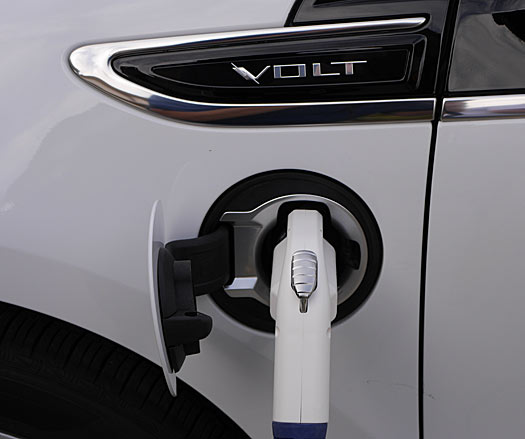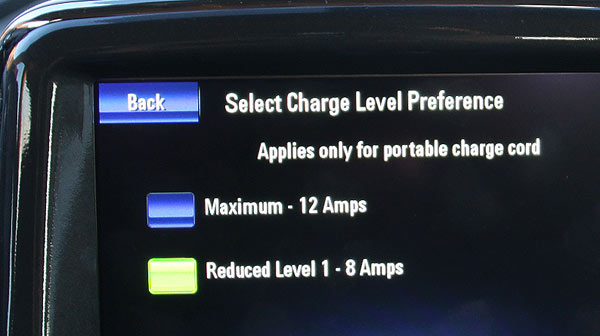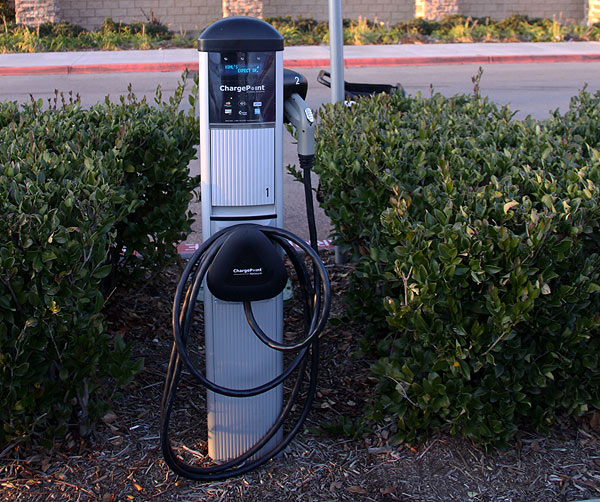
|
|---|
|
Beginners Guide to Electric Vehicles Introduction Electric Vehicle Types Choosing an Electric Vehicle Charging Technology Charging Your EV Home Charging Solar and Ways to Reduce Your Bill Contact the Author |
This page is from 2013 and has been rewritten Electric Vehicle Charging Be sure to check out our EV Charging Station buying guide  Instead of gasoline, you need electricity to propel your car. Where at a gas station you stick a liquid fuel nozzle into your car, for an electric car you put an electrical nozzle for pumping those electrons into your car to be stored in your battery. While you can fuel your liquid petroleum car in five minutes, providing a fill up to an electric car can take a lot longer depending upon the technology utilized. Most electric cars come with a 120 volt charge adapter that plugs into your wall socket. For a Chevrolet Volt this may take 12 hours to charge your car from empty. For a Nissan Leaf it may take a whole day. You may find that this works fine for you, and no faster charging source is needed. For most of us, we really need something faster. I have listed the charging options available to you. I am going to avoid the costs of these various options here as I have a page set aside just for that. Before deciding make sure you visit the cost section of the web site. Before I continue I need to provide an explanation of how charging systems function. When I refer to a charger station, I am talking about the box and cable that connects your car to the electrical grid. The actual charging system that manages the electricity being fed into your battery is in your car. The charging device that you plug into your car is kind of like a gate. It contains electronics that sense when the cable has been connected to the car. When this is accomplished it closes a relay that allows the electricity to flow into your electric vehicle. Some might ask why this elaborate system for charging? Well, think about it this way. You really don't want to be connecting a live plug into something that draws a significant current. You could get quite a shock if it was designed this way when your fingers got in the wrong place. As designed, the charge plug and cable are not energized when not plugged in. When you connect the plug into the vehicle the car will electronically hand shake with the charging station. Once the handshake is made the relay in the charging station will open, allowing electrons to flow to the car. When you disconnect the plug, the electricity stops flowing through the cable. Level 1 Charging This is the slow charging route that uses a standard 120 volt power outlet. If you only need to charge during the night for the morning commute then this may just work fine for you. Basically, you plug the device into the wall and the electricity flows to your car. Electric cars sometimes have the option of designating either a flow rate of 8 or 12 amps. If you are plugging into a dedicated electrical circuit then you should be able to charge at the 12 amp rate. If you are charging from a circuit that feeds multiple outlets and devices then the chances are your house may not be able feed a 12 amp load to your car. It would be wise to figure out what kind of wiring and circuit breaker you have on your outlet before you opt for the 12 amp rate. This is especially important when you visit your brother's house on Christmas and ask to plug in. I found out the hard way when I blew the circuit breaker that powered the garage, along with the living room Christmas Tree. Best case scenario is you might be able to squeeze five miles of range per hour of charge on a 12 amp load. If pulling 8 amps you can plan on three miles per hour.  Some electric cars have a user selectable charge setting to allow selection of lower amperage so you don't pop breakers.
Some electric cars have a user selectable charge setting to allow selection of lower amperage so you don't pop breakers.
The difference between 8 and 12 amps is the higher amperage rating will charge your car faster. Eight amps is like a trickle charger and it will take 12 hours to charge a Volt and probably 24 hours to charge electric vehicles with a larger battery. A Tesla Model S might take a few days to charge this way. If you commute you might be able to find a 120 volt outlet at your place of employment that is accessible to your car. While it may be slow to charge, you should be able to get a meaningful charge during your stay. You may want to ask permission as some car owners have reported being written up for stealing electricity. Sometimes it is is better to ask for forgiveness than to seek permission. Whatever approach you go with make sure you think it through. Level 2 Charging This is what you really want to install. Level 2 stations will typically allow your car to fully charge your car in 4 hours. While a Level 1 connector feeds 120 volts into your car, a Level 2 station can feed 240 volts that will charge your car in half the time of a Level 1. Higher wattage Level 2 stations can do this even faster if your car has the charging system to accommodate higher wattage protocols. While you can get by with a Level 1 charge adapter for a plug-in hybrid, or range extended car like the Chevrolet Volt, you really need a Level 2 system for an entirely battery powered car to allow for flexibility. Not all Level 2 charge stations are created equal. Cars like the Volt, some Leafs, and the Chevrolet Spark EV contain a lower capacity charger and can only process 3.6 kWh into the car. A real bummer, because commercial charge stations and many home units can supply 7.2 kWh. You can still plug into a larger capacity charger, it is just your car won't pull the maximum amount of power the station is capable of. My Volt will charge and deliver 38 miles of range in about 4 hours using the 3.6 kWh charging system. My Honda Fit EV will fully charge with 80 miles of range in about 3 hours using a 7.2 kWh charging system. I have created a dedicated web page with information concerning installing a Level 2 charging station.  Commercial charging stations found in parking lots are typically Level 2. I have never seen anything less than these. Someday we might see Level 3. Level 3 Charging Stations You can't install one of these in the home as they require three phase power. These chargers pump a lot of electricity into your car to quickly charge your car. While a Level 2 station can feed about 7000 watts into your car, this monster feeds more than 25,000 watts. We are talking 80% capacity in about a half hour. The problem with this technology, is according to reports, may shorten the long term life of the battery. Every so often it is ok, but if you want your battery to last you do not want to be doing this daily. Not all cars are compatible with this technology either. Tesla has a different protocol than other auto manufacturers and is not compatible with DC fast chargers other than those at Tesla owned stations. For home use focus on Level 1 and 2. Most of the time you will just be charging the car in your own home garage. Someday charging stations will be available everywhere, but for now this is not an option. If you live in an apartment forget owning an electric car unless you have facilities open to you for charging. Most apartments complexes do not have charging stations installed. In some states such as California the building code requires new commercial buildings to offer an electric vehicle charging station. You may be able to convince your employer to install a charging station for your use, or at least have access to a 120 volt outlet so you can get a top off at work. One common suggestion I hear is asking why electric car manufacturers do not place solar panels on the roof of electric cars to charge while the car is parked for the day. While this sounds like a neat idea, it is not practical. If a car's surface was covered with solar panels you might be able to pull about 50 watt hours of electricity, Think about how long it would take to get a meaningful charge. A standard 120 volt electrical outlets that takes eight hours to charge a volt can supply about 1400 watts per hour. A full solar charge would roughly take 350 hours. These are rough number, but you get the point. To answer your question, would you be willing to pay an extra few thousand dollars for a solar option that would take hundreds of hours to charge the car? Probably not. |